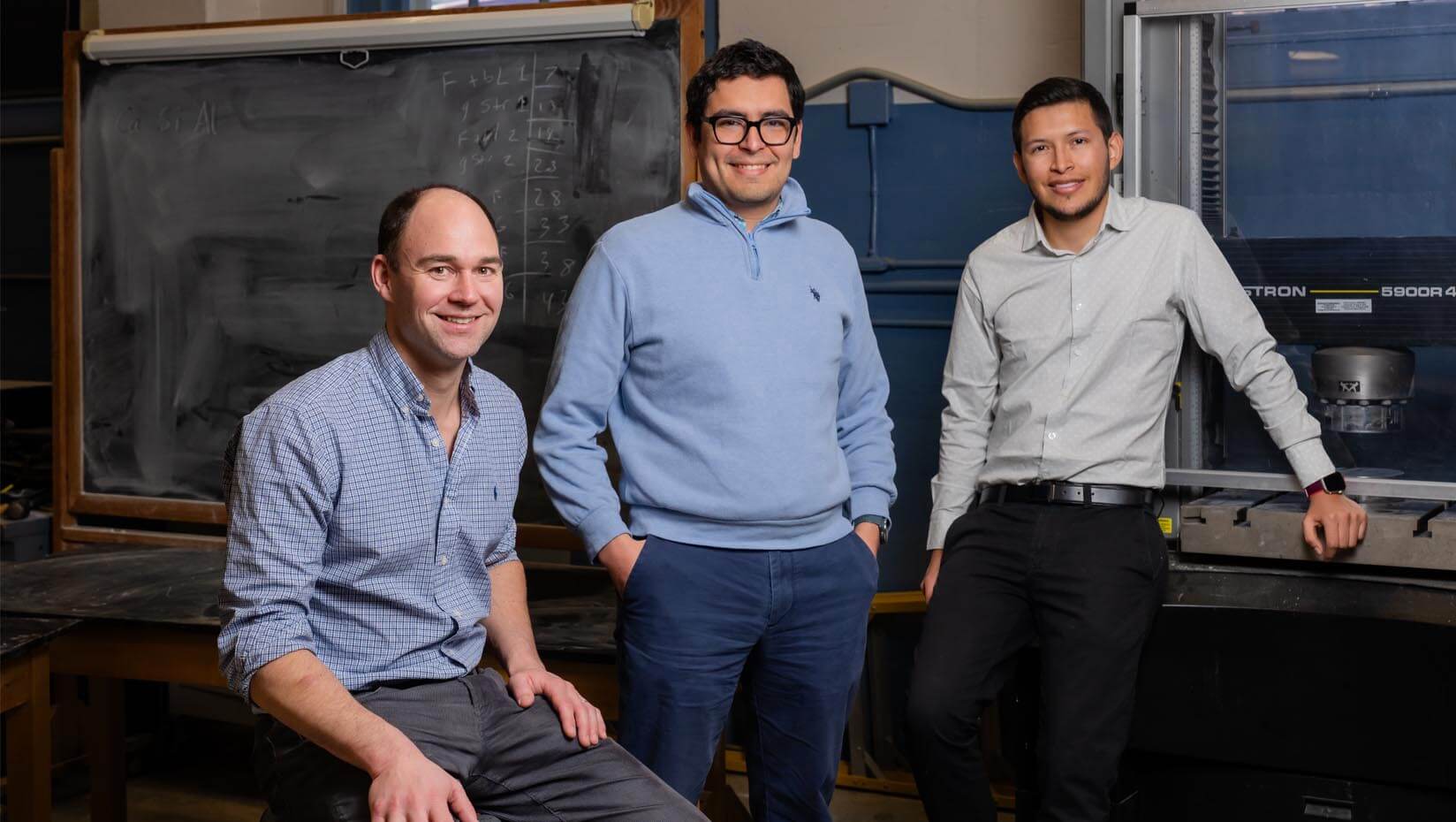
NSF backs UMaine research to lessen earthquake damage with new, inexpensive method
On the backside of a piece of paper he found at his desk, University of Maine associate professor of geotechnical engineering Aaron Gallant drew a microscopic view of soil to explain the foundation of his research. Inside a small square, he penned in circles of different sizes for two types of particles and wavy lines for groundwater flow through the soil. The smaller of the two particles represented tiny gas bubbles floating in water between soil grains, the larger of the two.
Although the soil is loose and deformable, Gallant said it’s stable as long as soil particles can compact and displace the groundwater. It can lose stability when vibrations from an earthquake create pressure in the ground and liquify soil with high water content. Known as liquefaction, the process is capable of destabilizing foundations under bridges, homes, oil tanks and other facilities, causing them to collapse.
The tiny gas bubbles represented in Gallant’s illustration may have the ability to effectively mitigate the damaging impacts of liquefaction by suppressing groundwater pressurization.
In partnership with Portland State University (PSU) in Oregon, Gallant and two other researchers from UMaine — assistant professor of civil and environmental engineering Luis Zambrano-Cruzatty and graduate student Andres Cordoba — are testing a new method of fortifying water-saturated soil. The team will be stimulating microbes in the ground that generate nitrogen gas to buffer ground pressure created by earthquakes, like shocks on a car.
The National Science Foundation (NSF) selected the team in a competitive grant process for an award of $961,871 to conduct the research, with UMaine’s share totaling $365,594.
“We’re thinking about how the ground interacts with a built environment,” said Gallant. “One of the things that is very difficult to mitigate is this idea of liquefaction, when the soil turns from a solid state essentially into what’s considered a liquid state.”
Regions prone to earthquakes and near water, such as the west coast, greater Charleston area in South Carolina and New Madrid seismic zone in the midwest, are specifically in danger of soil liquefaction in the U.S.
The inspiration
“This is something that can be very destructive,” said Gallant. “The specific site that we’re concentrating on here is the critical energy infrastructure hub in Portland, Oregon. They have a lot of oil tanks sitting on liquefiable soils. If a big earthquake happens, all of that oil and the state’s energy supplies are susceptible to this big, potentially catastrophic event.”
If the soil liquified during an earthquake, Oregon could lose 90% of its petroleum reserves.
Diane Moug, assistant professor of civil and environmental engineering at PSU, said since Oregon doesn’t have fuel refineries, all the liquid fuel is shipped to the infrastructure hub then distributed. The fuel tanks were built before the state understood the seismic hazard.
“These fuel tanks are not seismically robust,” said Moug. “They’re on soil that will fail in an earthquake.”
Besides the loss of liquid fuel for the entire state, Moug said people are concerned that if the tanks fail they will spill into the Willamette River causing harm to fisheries and ecosystems.
Since tanks and infrastructure are already there, she said improving the soil underneath is difficult. The gas-generating method the research team is studying is one of a few that can treat ground where infrastructure exists.
“There’s this nice synergy of us looking at how effective this method is for reducing earthquake hazards, and Gallant and his team are looking at how long it lasts,” said Moug. “We see those two questions as really intertwined. You can’t have one without the other.”
The multi-point research is an attempt to not only create a solution for soil liquefaction, but to make it cost effective and widely accessible — for resource-rich countries like the U.S. and other places like rural Indonesia that often experience earthquakes and are prone to liquefaction.
Following a 2018 earthquake in Indonesia, Gallant joined an NSF-funded research team associated with the Geotechnical Extreme Events Reconnaissance Association that traveled to the Southeast Asian country and studied the Palu-Donggala quake. Researchers concluded liquefaction from the earthquake had triggered catastrophic landslides that caused mass destruction and the death of more than 4,000 people.
New technique
Gallant’s research into mitigating liquefaction dates back to 2016 when he joined UMaine.
This most recent segment funded by the near $1 million NSF grant is specifically focused on fortifying silt soils over a long period of time by generating nitrogen gas with microbially induced desaturation (MID). Inexpensive compared to reinforcing building foundations or driving concrete pillars deep into the ground, the generated nitrogen gas absorbs pressure from earthquakes by filling empty space between soil particles and groundwater.
“It’d be very challenging to take a straw, blow bubbles into the soil and get it uniformly mixed,” said Gallant. “With MID, we’re essentially stimulating the microbes and getting a denitrification process rolling that will allow us to generate nitrogen gas in place.”
In addition to being a cost effective solution, Gallant said nitrogen gas isn’t damaging to the environment and will last a long time in the soil, potentially decades to a century. It doesn’t dissolve easily in water, and the atmospheric pressure of nitrogen — the gas with the highest naturally occurring concentration in the air — significantly contributes to the persistence and longevity of gas entrapped in the soil column.
“What happens when you open a Coke bottle? The CO2 comes out,” said Gallant. “But why was it staying there before? Because it had a lot of CO2 pressure inside the bottle.” The same concept applies to nitrogen gas in groundwater.
Two challenges will be knowing whether the gas is staying in place and predicting how long it will be there. If the research team can successfully address these concerns, MID and other desaturation techniques have the ability to transform how civil engineers protect infrastructure susceptible to liquefaction.
Contact: Ashley Yates; ashley.depew@maine.edu
